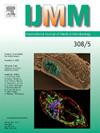Carbon source utilization in hybrid Shiga toxin-producing and uropathogenic Escherichia coli indicates uropathogenic origin
IF 3.6
3区 医学
Q1 MICROBIOLOGY
引用次数: 0
Abstract
To investigate the adaptation of hybrid Escherichia coli to the intestinal and extraintestinal milieu, we compared our model hybrid Shiga toxin-producing (STEC) and uropathogenic (UPEC) E. coli O2:H6 strains with non-pathogenic E. coli and canonical UPEC and STEC strains in a carbon source utilization assay testing 95 common carbon sources under aerobic and anaerobic conditions. Comparison of anaerobic to aerobic growth showed a 2-fold decrease and 2.5-fold increase in the growth capacity and lag phase, respectively. While the UPEC and STEC/UPEC hybrids retained the utilization of several organic acids, amino acids, and peptides, the STEC and non-pathogenic strains relied almost exclusively on the utilization of sugar compounds under anaerobic conditions. Cluster analysis indicated a higher degree of difference and separation between all strains under aerobic conditions. The UPEC, hybrids, and STEC strain B2F1 showed high similarities in aerobic carbon utilization following growth patterns observed in previous phenotype assays. Additionally, we observed known UPEC virulence traits, such as the aerobic utilization of D-serine in our model STEC/UPEC hybrids. Combined, these findings suggest that the intestinal STEC/UPEC O2:H6 isolates originated from a UPEC background and acquired the ability to cause intestinal disease with the addition of Shiga toxin as a virulence factor.
产志贺毒素和尿路致病性杂交大肠杆菌的碳源利用表明尿路致病性起源
为了研究杂交大肠杆菌对肠道和肠外环境的适应性,我们将模型杂交志贺产毒素(STEC)和尿源致病性(UPEC)大肠杆菌O2:H6菌株与非致病性大肠杆菌和典型UPEC和STEC菌株在好氧和厌氧条件下对95种常见碳源进行了碳源利用试验。厌氧生长与好氧生长的对比表明,生长能力和滞后期分别下降2倍和2.5倍。虽然UPEC和STEC/UPEC杂交菌株保留了对几种有机酸、氨基酸和肽的利用,但STEC和非致病性菌株几乎完全依赖于厌氧条件下对糖化合物的利用。聚类分析表明,各菌株在好氧条件下具有较高的差异和分离程度。UPEC、杂交菌株和产肠毒素菌株B2F1在有氧碳利用方面表现出高度的相似性,这是在之前的表型分析中观察到的。此外,我们观察到已知的UPEC毒力特征,例如在我们的模型STEC/UPEC杂交株中d -丝氨酸的有氧利用。综上所述,这些发现表明肠道STEC/UPEC O2:H6分离株起源于UPEC背景,并通过添加志贺毒素作为毒力因子获得了引起肠道疾病的能力。
本文章由计算机程序翻译,如有差异,请以英文原文为准。
求助全文
约1分钟内获得全文
求助全文
来源期刊
CiteScore
9.70
自引率
0.00%
发文量
18
审稿时长
45 days
期刊介绍:
Pathogen genome sequencing projects have provided a wealth of data that need to be set in context to pathogenicity and the outcome of infections. In addition, the interplay between a pathogen and its host cell has become increasingly important to understand and interfere with diseases caused by microbial pathogens. IJMM meets these needs by focussing on genome and proteome analyses, studies dealing with the molecular mechanisms of pathogenicity and the evolution of pathogenic agents, the interactions between pathogens and host cells ("cellular microbiology"), and molecular epidemiology. To help the reader keeping up with the rapidly evolving new findings in the field of medical microbiology, IJMM publishes original articles, case studies and topical, state-of-the-art mini-reviews in a well balanced fashion. All articles are strictly peer-reviewed. Important topics are reinforced by 2 special issues per year dedicated to a particular theme. Finally, at irregular intervals, current opinions on recent or future developments in medical microbiology are presented in an editorial section.

 求助内容:
求助内容: 应助结果提醒方式:
应助结果提醒方式:


